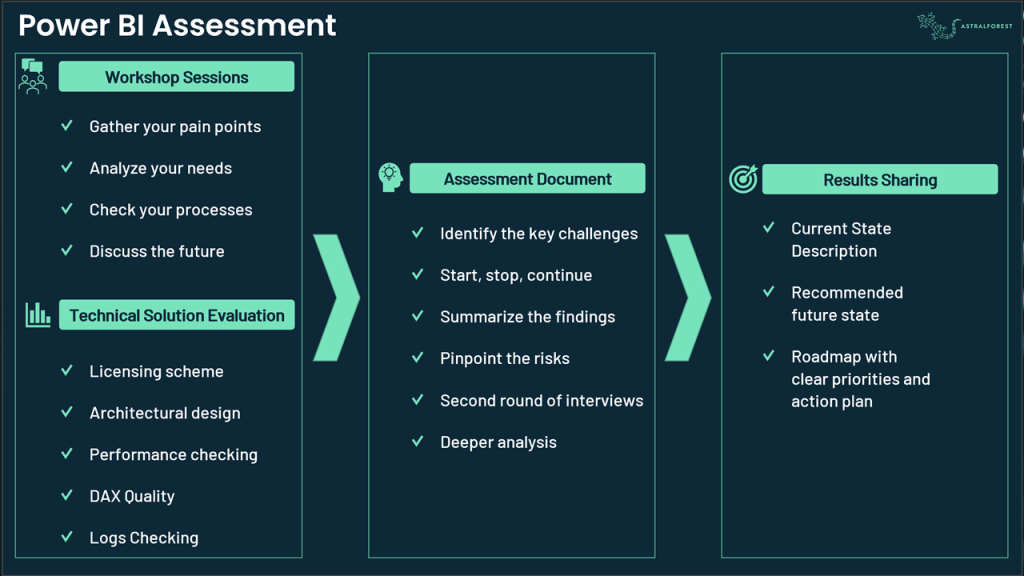In Astral Forest, we help ambitious BI leaders get 100% control over the solutions they manage through technical expertise and process know-how advisory. I’m Michał Dębski and I decided to share how we conduct a Power BI Assessment with you.
Power BI Assessment: an intelligent way to evaluate the 3 pillars
In our assessment, we’re going through the 3 pillars described by Stan here.
- People: We evaluate the cooperation between IT services and the data-driven BUs and departments. We take a closer look at the BI change management processes, the communication materials and the Power BI training programs. Finally, we also evaluate the technical competency of your team(s). We always make sure to do it in a friendly way, as the people you have are your most crucial asset.
- Process: We study carefully all the processes around your Power BI reports. We engage both the business owners and the Business Intelligence team. We discover how the reports are created and maintained, how the validation process looks, and how the satisfaction level is measured. Power BI Adoption Strategy is evaluated together with Power BI governance.
- Technology: We evaluate the Power BI technological & architectural perfection. We run a deep technical analysis of the data models, DAX, Power BI Service setup and ETL. It’s always wise to check your team’s toolset to work more efficiently (e.g. Tabular Editor, Deneb, Dax Studio). As the reports’ performance and user-friendliness are crucial, we also check these aspects. We’ll take a look at your licenses – that’s where we often find low-hanging fruits and possibilities for reducing costs.
Evaluating the 3 pillars is necessary to learn where you are and where you may lag. Even Sun-Tzu, a Chinese military strategist and philosopher, advised that knowing the terrain you play is essential to winning. Although in “The Art of War” he teaches how to win the war by understanding the topography of the physical battleground, his ideas are applicable also in the business. Using this terrain analogy, you should master your playground and prepare your strategy considering the 3 pillars.
Power BI Assessment – What does the efficient process look like?

As you can see, the process of conducting the Power BI Assessment is straightforward:
- Workshop sessions: We start with interviews and discussions with the key stakeholders (we address Process and People Pillars)
- Technical Solution Evaluation: Simultaneously, we run the Power BI Technical Solution Evaluation of your environment (Technology Pillar is addressed)
- Analysis of the gathered information: We analyse the findings and summarise it all in the documentation.
- Result sharing: During a meeting, we share the details of our work with you. All the created documents are yours (such as the Power BI Assessment summary and Power BI Roadmap).
Let’s go into more details about each step right now.
Power BI Assessment: Workshop Sessions a robust key to success?
To kick off the Power BI Assessment, we start with a workshop session. It allows us to evaluate your current maturity level and use this information to craft the optimal solution. Mixing “Top to bottom” with “Bottom-up” approaches for the Power BI Assessment is the way I always recommend.
Why? Because only by doing so I am sure I can gather all the needed information.
I like to capture the views of both executives and operational employees. It makes it possible to compare the executives’ strategic vision of Business Intelligence with the perception of the specialists. So let’s be sure not to miss a thing and include the following people in the workshop sessions:
- Power BI Adoption Sponsor – it’s not a job title. It’s a person interested in the wide adoption of the tool. Depending on the organisation, it may be the head of analytics, director of financial reporting or director of controlling. It must be a person with a strong drive towards the results and responsible for the success of Business Intelligence tools.
- CIO/ Head of Data – Power BI is the user interface of the entire data platform in your organisation. We must understand the point of view of the leader of this platform and consider her stance.
- Data Solution/Center of Excellence team members – discussing with developers is the best way to overview the team’s technical maturity. It helps to identify the flaws in the current processes.
- Business Users/Customers – They are at the centre of BI Solution; their feedback is crucial to identifying the problems. We always advise including the business users in all significant actions regarding Power BI. It builds their engagement and increases the adoption.
- Data Solution Architect – This person has a 360 vision of the data solution. She can also share views about the skill level of the team and training quality.
It’s perfectly normal if you don’t have all of the above-mentioned roles in your organisation. Your organisation may also use different names for these roles.
Do you have some doubts who should you engage in Power BI Assessment? Drop me an email. I’ll be happy to have a chat with you.
I want to give you an idea about the different needs of customers. Please remember that the exact scope of the Power BI assessment is always defined individually. Sometimes the assessment is more technology-oriented, e.g. skewed towards performance and development best practices.
On the other hand, for some of my customers, I focus more on processes (BI Change Management, delivery, maintenance, DevOps, internal marketing). In different situations, a customer asks for Power BI Assessment covering many diverse issues, including those people-oriented (education, maturity).
It is the end of the first part. I will publish the second one shortly. Do not hesitate to write to me if you have any thoughts about the described part of the process. Enjoy your day!


0 Comments